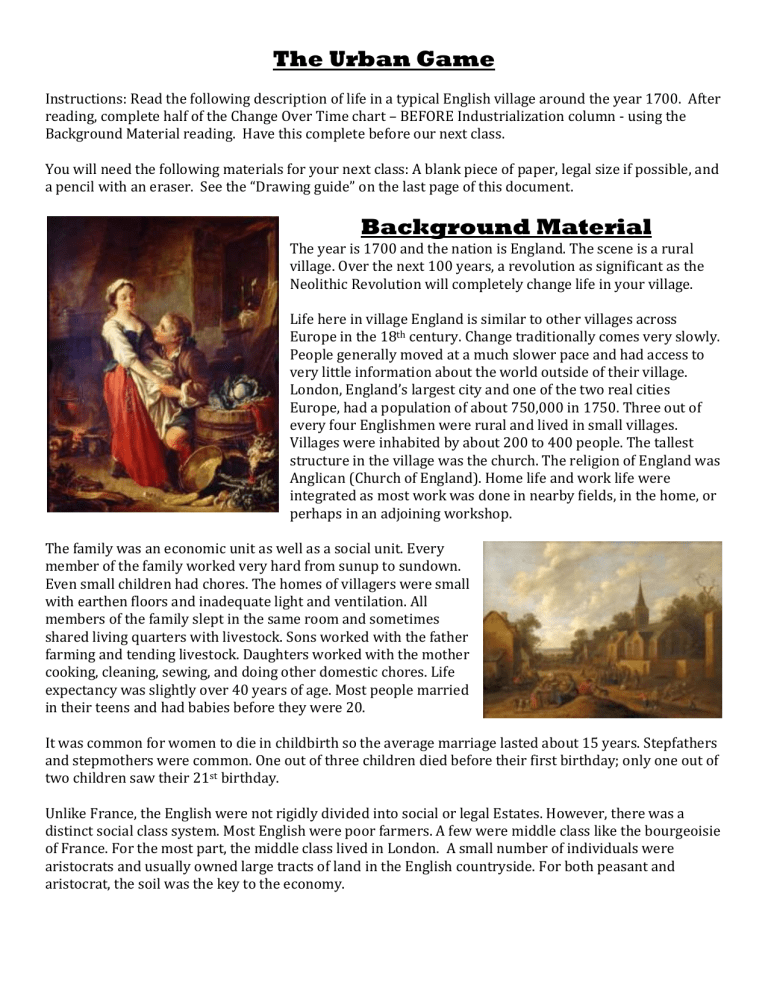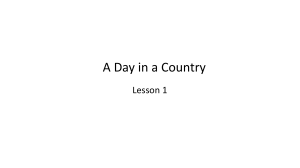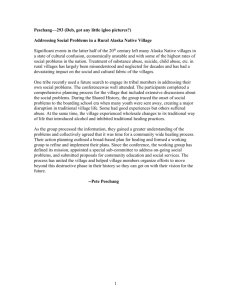
The Urban Game Instructions: Read the following description of life in a typical English village around the year 1700. After reading, complete half of the Change Over Time chart – BEFORE Industrialization column - using the Background Material reading. Have this complete before our next class. You will need the following materials for your next class: A blank piece of paper, legal size if possible, and a pencil with an eraser. See the “Drawing guide” on the last page of this document. Background Material The year is 1700 and the nation is England. The scene is a rural village. Over the next 100 years, a revolution as significant as the Neolithic Revolution will completely change life in your village. Life here in village England is similar to other villages across Europe in the 18th century. Change traditionally comes very slowly. People generally moved at a much slower pace and had access to very little information about the world outside of their village. London, England’s largest city and one of the two real cities Europe, had a population of about 750,000 in 1750. Three out of every four Englishmen were rural and lived in small villages. Villages were inhabited by about 200 to 400 people. The tallest structure in the village was the church. The religion of England was Anglican (Church of England). Home life and work life were integrated as most work was done in nearby fields, in the home, or perhaps in an adjoining workshop. The family was an economic unit as well as a social unit. Every member of the family worked very hard from sunup to sundown. Even small children had chores. The homes of villagers were small with earthen floors and inadequate light and ventilation. All members of the family slept in the same room and sometimes shared living quarters with livestock. Sons worked with the father farming and tending livestock. Daughters worked with the mother cooking, cleaning, sewing, and doing other domestic chores. Life expectancy was slightly over 40 years of age. Most people married in their teens and had babies before they were 20. It was common for women to die in childbirth so the average marriage lasted about 15 years. Stepfathers and stepmothers were common. One out of three children died before their first birthday; only one out of two children saw their 21st birthday. Unlike France, the English were not rigidly divided into social or legal Estates. However, there was a distinct social class system. Most English were poor farmers. A few were middle class like the bourgeoisie of France. For the most part, the middle class lived in London. A small number of individuals were aristocrats and usually owned large tracts of land in the English countryside. For both peasant and aristocrat, the soil was the key to the economy. Land was the source of livelihood and well-being. Having enough land to produce adequate food, or to produce enough to sell, or even to rent, was the key to economic survival. These traditions concerning land guided daily living. These traditions were designed to ensure the stability and welfare of the greater community. Hence marriages and inheritance were geared to maintaining family property intact. Marriages were arranged by parents to maintain or better the economic status of their sons or daughters. However, not all could get married. A man usually had to own land on which to support a family before he dared marry. It was not uncommon for men to wait until their 30’s when they inherited land from their parents which enabled them to marry. If a woman did not bring land into a marriage, she had to have some kind of dowry. Daughters who inherited property from their parents had to pass it on to their husbands. All land was given to the eldest son (primogeniture) while younger sons might receive cash payment or wait for their older brother to die. The main occupation of England was farming. Unlike today, fences did not separate private and public lands. Every village had a public area called the commons. This land was available to anyone for pasturing, hunting, gathering of firewood, and growing of crops. So poor farmers who did not own their land could eke out a marginal living by depending on the commons. Unlike France, most English peasants or farmers did own their own land, however small. Villages were connected by a system of dirt roads that became impassable during the wet season. As a result, transportation was often slow and trade beyond the village was not easy. Most English farmers never visited any place further than 25 miles from their birthplace, ever! People made their own food, clothes, furniture, tools, and homes. A few items that could not be produced could be obtained from wandering peddlers. Finally, for fuel, there were two sources: firewood and coal. Nearly every English village had a coal mining operation. These mines employed a small number of village dwellers, especially in the winter. Coal was extracted from pits that were privately owned. Name: ________________________________________________ Date: _________________ Change over Time: Industrial Revolution People earned a living by… BEFORE Industrialization Farming (tending animals, growing crops), some artisan tasks (weaving, housekeeping, cooking, etc..) mining (coal to use as fuel to keep warm in the winter. Tools used were usually… Dirt roads, firewood, coal, the commons (publicly owned farm land) People traveled by… Horse, foot Work hours were determined by… The sun and the individual family. The role of children was to… Do chores, help around the house, domestic work. Clothing and food were made by… The mother/woman/daughter Sources of power included… Firewood/coal Other changes included… AFTER Industrialization






